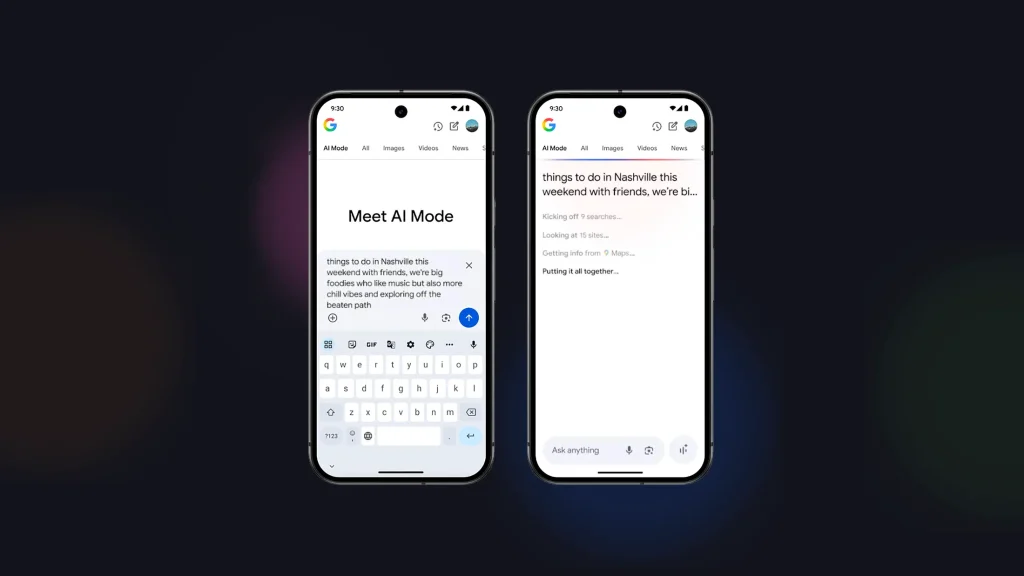
This week’s roundup highlights major shifts in Google Search, driven by AI enhancements and refined content standards. Google is pushing forward with AI Mode, offering a more immersive, generative search experience that integrates features like interactive financial data visualizations. At the same time, updates to the ranking algorithm and SafeSearch guidelines tighten how explicit content and videos are surfaced. For SEOs focused on technical implementation, structured data guidelines for events and recipes have also been updated—impacting eligibility for rich results. These updates reflect Google’s ongoing mission to make search smarter, safer, and more interactive.
Google has introduced AI Mode, a new feature in Search that enables users to pose complex, multi-part questions and receive comprehensive, AI-generated responses. This new experience, powered by Google’s Gemini 2.5 model, is designed to handle nuanced queries in natural language, moving beyond traditional keyword-based searches.
A More Conversational Search Experience
AI Mode offers a conversational interface, allowing users to ask follow-up questions and delve deeper into topics. For example, a query like “things to do in Nashville this weekend with friends, we’re big foodies who like music but also more chill vibes and exploring off the beaten path” yields tailored suggestions, including restaurants with outdoor seating and local events.

Enhanced Personalization and Contextual Understanding
The development of AI Mode was driven by user feedback indicating a desire for more predictable and comprehensive AI responses. Users appreciated AI Overviews but wanted greater control over when and how AI assistance appeared in their searches. In response, Google designed AI Mode to provide a more interactive and personalized search experience.
Integration with Google’s Ecosystem
Currently rolling out in the U.S., AI Mode is accessible via a new tab in Search and a shortcut in the Google app’s search bar. This feature represents a significant step in Google’s mission to make information more accessible and useful through advanced AI capabilities.
Looking Ahead
As AI continues to shape the future of search, Google’s AI Mode exemplifies the company’s commitment to evolving its services to meet user needs. By integrating advanced AI capabilities into Search, Google aims to provide users with more intuitive and efficient ways to access information.
Google has released a new feature in its AI Mode that brings interactive chart visualizations to financial queries, enhancing the way users engage with financial data. This update allows users to receive dynamic graphs and comprehensive explanations tailored to their specific questions about stocks and mutual funds.
For instance, when a user asks, “Compare the stock performance of blue chip CPG companies in 2024,” AI Mode processes the query using Gemini’s advanced reasoning capabilities to generate an interactive graph alongside a detailed analysis. Users can further inquire with follow-up questions like, “Did any of these companies pay back dividends?” and AI Mode will understand the context to provide relevant information.
Under the hood, this feature leverages real-time and historical data, intelligently determining the best way to present information to help users make sense of complex financial topics. By integrating these interactive visualizations, Google aims to make financial data more accessible and easier to understand, assisting users in making informed decisions.
This feature is currently rolling out in AI Mode within Google Search Labs.
Google has rolled out updates to its search ranking algorithms and SafeSearch documentation aimed at better managing explicit content, especially videos. These changes are part of an ongoing effort to improve user safety and ensure that explicit material is properly filtered in search results when SafeSearch is on.
Key Ranking Algorithm Updates
Updated SafeSearch Guidelines
<meta name="rating" content="adult"> and the <video:family_friendly> tag in video sitemaps.Troubleshooting and Recovery
If you suspect your content is being filtered unfairly:
These updates reflect Google’s continued emphasis on search safety, urging webmasters to clearly label explicit content and provide unhindered access for proper indexing.
Google has recently updated its structured data documentation for both events and recipes, aiming to enhance how this content is presented in search results. These changes are designed to improve the accuracy and clarity of information displayed to users.
Event Structured Data Updates
eventAttendanceMode and location with virtual event values. This change reflects a shift in how online events are represented in search.Recipe Structured Data Updates
image property is required for recipes to be eligible for rich results. This ensures that recipes are accompanied by relevant visuals, enhancing user engagement.These updates underscore Google’s commitment to providing users with clear and useful information in search results. Webmasters and content creators are encouraged to review these changes and adjust their structured data accordingly to maintain optimal visibility in search.
With AI transforming how content is presented and technical updates reshaping how it’s understood, this week’s changes are a clear reminder: SEO today is as much about experience and structure as it is about keywords. Whether you’re optimizing for AI summaries, ensuring your content aligns with new SafeSearch standards, or updating structured data for events and recipes, staying informed and adaptable is key. We’ll continue tracking these developments to help you keep your strategy aligned with where Google Search is headed next.